| Return
to History of the Area
Scotts
Run
America's Symbol of the Great Depression
in the Coal Fields
RONALD L. LEWIS
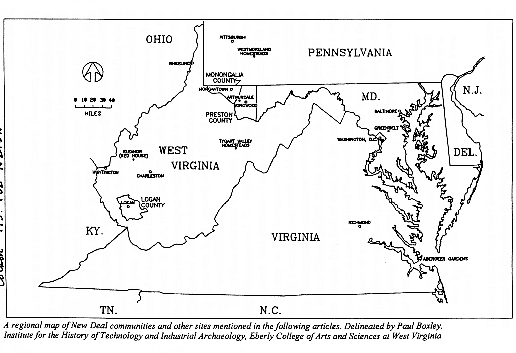
Arthurdale's
60th anniversary slogan proclaims that "The
Dream Lives On." The story of this New Deal
community is affirmative and inspiring, a tale
of triumph against the odds, the kind of story
Americans embrace. The dream of Arthurdale was
born out of the chronic despair that First Lady
Eleanor Roosevelt found upon personal investigation
into the living conditions along Scotts Run in
1933. But the nightmare of poverty on Scotts Run,
which spurred New Deal reformers in the first
place, has faded during the last half-century
of relative prosperity. Nevertheless, the dream
and the nightmare are interdependent, and so,
as a preface to the chapters which follow in this
volume, it is appropriate to reflect briefly on
the historical significance of Scotts Run. The
rapid rise and dramatic fall of King Coal in this
five-mile-long coal hollow located in Monongalia
County, West Virginia, is a case study of how
the unrestrained capitalist development of the
late-nineteenth and early twentieth centuries
triggered explosive economic growth, on the one
hand, and unrelenting human misery on the other.
Poverty
was not always associated with the Scotts Run
coal field. Coal companies and speculators began
to accumulate mineral rights there in the late-nineteenth
century. However, the transition from an agricultural
to an industrial economy did not make any significant
headway until World War I stimulated the demand
for coal to fuel the national war machine. Monongalia
County produced a mere 57,000 tons of coal in
1899, and only 400,000 tons in 1914, but by 1921,
tonnage soared to nearly 4.4 million tons.(1)
Most of this expansion was attributable to the
development of Scotts Run where, during its peak
years in the mid-1920s, coal companies owned 75
percent of the taxable acres and thirty-six mines
extracted coal from underground. In fact, the
narrow five-mile hollow was one of the most intensively
developed coal districts in the United States,
with a minimum of seventy-three coal companies
in operation between 1917, when the field opened,
and 1942, a period of intense coal company consolidation.(2)
Scotts
Run coal was developed against a background of
unrestrained boosterism. I. C. White, the state
geologist and Morgantown resident, was unabashed
in his writing of the potential for the coal industry
in the Morgantown field. In a 1923 issue of Black
Diamond, a leading coal trade publication, White
observed that in the four commercial coal seams
of Scotts Run, located on the west side of the
Monongahela River across from Morgantown, were
found twenty-five feet of coal; on the east side
of the river were another four seams of fifteen
feet, totaling forty feet of coal. "These
eight seams of minable commercial coal, all being
operated from Morgantown as a center, give this
favored region the unique distinction of having
more coal in its immediate vicinity than any other
city of the world," White proclaimed.
How
is it possible to exaggerate the wonderfully
prosperous future that unfolds itself in the
horoscope of Morgantown.... What the future
has in store for this remarkable coal field
remains to be seen. It has made history in the
coal industry since the day it was opened.(3)
This
was more than mere boosterism, however, for Black
Diamond informed its subscribers in that same
year that "in no section of West Virginia's
many mining districts has the development of a
coal field been more phenomenal than in the history
of Scotts Run."
While
boosterism helped, it does not fully explain the
rapid development of Scotts Run. There were several
important strands of economic reality which converged
at this moment in this previously obscure rural
hollow. Most importantly, geology determined that
Scotts Run would be the place that provided easy
entry into the Pittsburgh seam, considered by
many experts to be the most valuable mineral deposit
in the world. At Scotts Run, the seam was exposed
at 170 feet above the Monongahela River. The Sewickley
seam, located about ninety feet above the Pittsburgh,
was considered the best quality locomotive coal
in the nation.(4) While less economically important,
two other minable seams added to the value of
coal properties along the run.
Nature
played an important role in capturing the attention
of coal producers, but World War I unleashed the
pivotal chain of human events which made development
possible. Coal prices in the national market doubled
under wartime stimulation, and it is significant
that the first commercial mine on the run dates
from 1917. Transportation was another key factor.
Scotts Run flows into the Monongahela River, which
already carried more freight originating along
its banks than any other.river in the hemisphere.(5)
With
the rapid development of railroads, the transportation
infrastructure for shipping coal to market was
in place. In 1910, the Morgantown and Dunkard
Valley Railway, an electric trolley line, was
completed from Morgantown to the mouth of Scotts
Run, and up the run to Cassville in 1911.(6) The
Morgantown and Wheeling Railway took over the
line in 1913 with plans to complete the line to
Blacksville, in the western part of the county,
to connect with steam trains, and then to continue
on to Wheeling. The following year, the Buckhannon
and Northern Railroad, built south from Brownsville,
Pennsylvania, connected with the Morgantown and
Wheeling at Randall at the confluence of the run
and the Monongahela River. Between 1915 and 1925,
and after a complicated financial history, these
various lines were purchased by the Monongahela
Railway. In 1921, 175 coal cars per day originated
from Scotts Run mines and were transported over
two sets of double tracks; by 1924, that number
had reached an average of two hundred cars a day
and the markets reportedly were slow.(7)
Finally,
Morgantown, whose businessmen were deeply engaged
in Scotts Run, was a full-fledged service center
for industrial development. The Monongalia County
seat, Morgantown had a well established and diversified
business community serving 16,000 people in the
early 1920s. Moreover, it was the hub of an emerging
transportation nexus of road, river, and railroad
traffic with power plants to supply electricity
for coal mines. According to I. C. White, however,
the greatest advantage offered by Morgantown was
the proximity of six excellent banks which helped
to finance the development of Scotts Run and assisted
in "the growth of Morgantown as the greatest
coal center in northern West Virginia."(8)
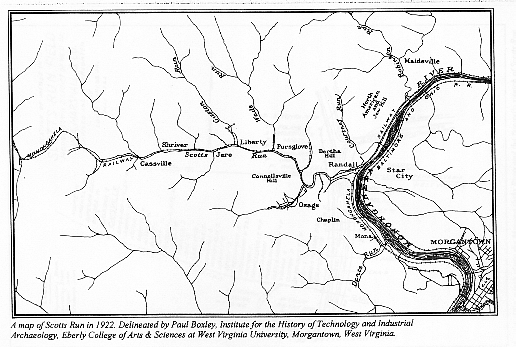
One of the most significant and unique features
of development along Scotts Run was its density.
Generally, developers leased their coal lands
by the acre, but on the run they leased both by
the acre and by the seam. As a result, two operations
standing side by side might be mining two different
seams, a practice which encouraged the multiplication
of coal companies with access to these rich seams
in a very confined space, and which subsequently
would have dire social and economic consequences.
The potential for legal conflicts, and danger
to working miners, is illustrated in the unusual
suit brought to court in 1924 by Chaplin Collieries,
which mined the Sewickley seam above the Pittsburgh
seam being mined by Pursglove Coal Mining Company.
Chaplin charged Pursglove with operating the mine
in a manner which threatened Chaplin's mine and
the safety of his employees. The court apparently
agreed and ordered Pursglove to change his method
of mining in order to protect Chaplin's operation
in the Sewickley seam. Black Diamond, which carried
a regular weekly column on coal news from Monongalia
County, observed that "practically all of
the land in Cass district in the coal belt has
both Sewickley and Pittsburgh coal under it and
in most instances the veins are owned by different
parties."(9)
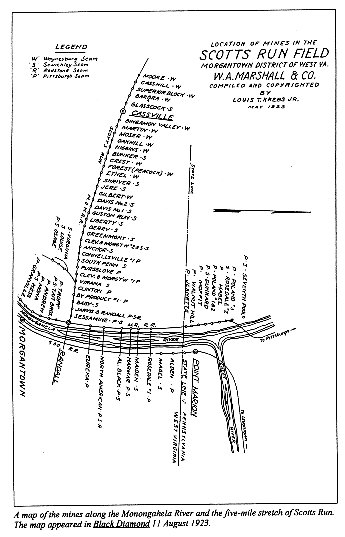
Rapid
industrial development on Scotts Run brought an
equally profound social transformation to this
rural hollow as mining replaced farming as the
chief means of earning a livelihood along the
run. Farmers and farm laborers comprised 66 percent
of the heads of household in Cass District in
1880 and mining only 2 percent; by 1920, coal
mining was 63 percent and farming had declined
to 21 percent. What this meant to people who had
lived there for generations is suggested by an
item published in a 1923 issue of Black Diamond,
which described Cassville as:
…a
sleepy little village that has been there for
years. Its residents do not yet comprehend what
has taken place in their little community to transform
it into a great hive of industry, with rows of
dwellings, stores, schools, churches, power houses,
generating stations, and tipples that lie in an
almost unbroken line for five miles.(10)
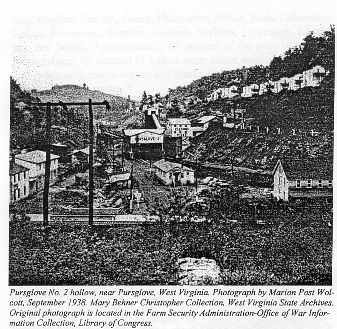
As in southern West Virginia, coal development
on Scotts Run required more workers than the local
labor market could supply. Therefore, companies
imported foreign-born immigrants and African-Americans
from the South and thereby precipitated a rapid
increase in the population. An exact calculation
of the population inot possible because the run
is a geographical rather than political sub-division
of Cass District, and the censuses do not always
indicate the exact location of residents. Also,
the decennial censuses for 1920 and 1930 did not
record the surge in population which peaked during
the 1 920s at about four thousand.(11)
Nor is it likely that census-takers differed in
this case in their reluctance to search out coal
camps hidden from view or considered "too
tough" for the census-takers to enter. Moreover,
although the actual number of workers who commuted
to jobs at Scotts Run mines is unknown, a significant
proportion of the work force fell into that category.
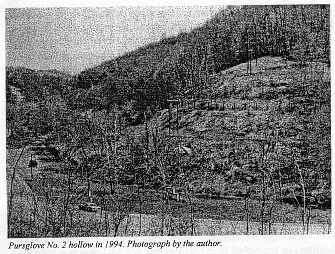
Mirroring the pattern reflected in other West
Virginia coal fields, and indeed the American
coal fields generally, the importation of workers
also resulted in a racially and ethnically diverse
population. In fact, one of the distinguishing
characteristics of the population of Scotts Run
during the boom years was the diversity of its
composition. The 1920 manuscript census identified
the following foreign-born ethnic nationalities
among the adult (voting age) residents of Scotts
Run: Austrian, Bohemian, Canadian, Croatian, English,
Finnish, Greek, Hungarian, Italian, Irish, Lithuanian,
Polish, Romanian, Russian, Scottish, Serbian,
Slovenian, Ukrainian, and Welsh. Approximately
60 percent of the population were foreign-born,
93 percent of whom were either southern or eastern
European, with native whites and blacks divided
about equally at 20 percent for each group.(12)
The
year 1923 was a momentous watershed in the Scotts
Run coal industry. That year was probably the
high-water mark in production at 4.4 million tons,
but it also was the beginning of a downward spiral
which ultimately led to the depopulation of this
hollow community. The boom lifted the run to prominence
in coal production, but it lasted only seven years
before larger social and economic forces reversed
the process. The "war to make the world safe
for democracy" ended in 1919, and with it
government regulation of the industry. In order
to maintain war production, a government brokered
agreement between industry and labor recognized
the United Mine Workers of America (UMWA) as the
miners' agent, but that grudging compromise was
retracted by industry after the war.(13) In northern
West Virginia, coal operators adhered to a non-union
policy prior to the war, and after the armistice
was signed, they awaited their opportunity to
return to the status quo antebellum. One obstacle
blocking their immediate return to prewar conditions
in the Fairmont Field was the fact that C. W.
Watson of Consolidation Coal Company, the dominant
producer in the region, had recognized the union
in 1918 in hopes of carrying the miners' votes
during his campaign for the U. S. Senate. Watson
failed in that quest, but he was forced to accept
the union until there was an appropriate pretext
for rejoining his non-union colleagues. That pretext
came in 1922. By then, the war-heated demand for
coal had cooled significantly, and President Warren
G. Harding lifted federal regulation of the industry,
thus opening the way for an "open shop"
drive by the coal producers.(14) In 1923, officers
of the UMWA and the Central Competitive Field
fashioned, and then early in 1924, signed the
Jacksonville Agreement which maintained the 1922
wage scale Shortly thereafter, the Northern West
Virginia Coal Operators' Association met with
UMWA representatives in Baltimore and ratified
the national accord. Both contracts were to last
until 1927.(15)
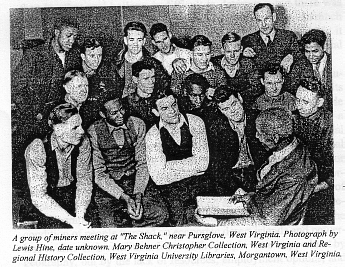
In West Virginia, the Fairmont field operators
were alone among the state's coal operators in
signing the agreement, convinced that their companies
could compete with non-union labor in the southern
West Virginia fields. They were wrong, and as
coal prices plummeted to their lowest level in
the market, the northern operators abrogated the
Jacksonville/Baltimore Agreement, thereby precipitating
a seven-year coal war in northern West Virginia.
This disastrous series of strikes and lockouts
lasted from 1924 until 1931. The northern West
Virginia mine war was the longest strike in the
state's colorful industrial history, and it cast
the miners and their families into destitution
and misery, and many of the operators into bankruptcy.'
In
1928, with the UMWA in ruin, President John L.
Lewis granted the districts the power to negotiate
their own separate contracts. This left the door
open for the National Miners Union (NMU), a stalking
horse for the Communist Party, to organize the
miners. Under the NMU banner, Scotts Run miners
went out on strike in 1931 against further wage
cuts that already sagged below subsistence levels.
An American Red Cross report called this strike
"the most peculiar strike in history"
because it was directed against consumers who
paid too little to sustain a living wage, rather
than against the operators. After a month's stoppage,
the Scotts Run operators recognized the UMWA,
presumably rather than risk legitimizing the NMU,
a strategy followed by operators in the adjacent
southwestern Pennsylvania coal fields, and the
long, bitter, and frequently violent strike came
to an end. The strike settlement proved to be
the beginning of the UMWA's resurgence. The end
of the seven-year coal war did not bring a return
to prosperity, however, for by 1931, the Great
Depression also had tightened its hold on Scotts
Run miners, many of whom had been without real
work for years. Thus weakened, the economic landslide
fell on them with a merciless fury that drove
most of them into abject poverty.
It
was in this pitiful condition that Scotts Run
became America's symbol of the Depression in the
coal fields and set a new standard for measuring
human suffering in the country which saw itself
as "the last best hope of man." To what
degree life was worse here than in other coal
hollows is difficult to determine, but there was
plenty of misery to go around. Ironically, Scotts
Run received much more attention than other depressed
coal communities because it was far more accessible
to outside photographers, reporters, social workers,
and government agencies.
This
begs the question of just how "isolated"
Scotts Run actually was in the 1920s and 1930s,
a perspective tightly linked to its public identity.
It should be noted that the run was easily accessible
by bus, auto, trolley, or train during this period,
and it was only a few miles from the county seat
of Morgantown. The commercial center of the county,
Morgantown itself was linked into the national
transportation network which connected the hinterland
with major metropolitan centers. Even though outside
observers usually portrayed Scotts Run as "isolated,"
its spatial relationship to the rest of the world
is more accurately understood as "stranded,"
a term frequently employed by contemporary relief
workers to describe the condition of people trapped
on economic desert islands and powerless to alter
their condition. Most of the people were trapped
not by geography, but by the lack of resources,
employment options, and by their culture--many
could not speak English and had customs which
imposed a social distance between them and native-born
residents. A significant percentage were African-Americans,
and racism must be added to culture as an explanation
of why many were stranded" on Scotts Run.
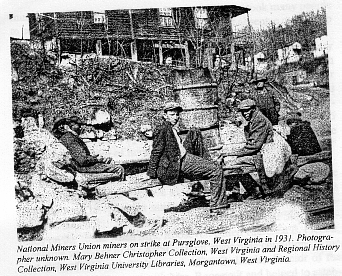
Undoubtedly,
the personal attention of First Lady Eleanor Roosevelt
did more than anything else to focus national
attention on Scotts Run. Lorena Hickok, Eleanor
Roosevelt's personal confidante and emissary,
was sent into the Pennsylvania and West Virginia
coal fields on a fact-finding mission in 1933,
and was escorted by Morgantown relief workers
to Scotts Run. There she "came upon a gutter
along a village street filled with stagnant, filthy
water used for drinking, cooking, washing, and
everything else imaginable by the inhabitants
of ramshackle cabins that most Americans would
not have considered fit for pigs," she reported
to Harry L. Hopkins. "Within these shacks,
every night children went to sleep hungry, on
piles of bug-infested rags spread on the floor."
Lorena
Hickok's cry of despair promptly brought Eleanor
Roosevelt for a personal examination of conditions
in the mine camps near Morgantown, and she too
was appalled by conditions on Scotts Run. In her
autobiography, Mrs. Roosevelt related a story
similar to that reported by Hickok regarding the
unsanitary condition of the water supply. "The
Run in Jere, like all the others that, ran down
the gullies to the larger, main stream,"
she observed, "was the only sewage disposal
system that existed. At the bottom of the hill
there was a spigot from which everyone drew water.
The children played in the stream and the filth
was indescribable."(20 ) Another experience
which distressed her occurred in a company house
where a man showed the First Lady his weekly pay
slips. After the usual deductions for rent and
the company store, he was left with less than
one dollar per week to feed his six children.
"I noticed a bowl on the table filled with
scraps, the kind that you or I might give to a
dog," Mrs. Roosevelt wrote, "and I saw
children, evidently looking for their noon-day
meal, take a handful out of that bowl and go out
munching. That was all they had to eat."
Eleanor took many people to see Jere, "for
it was a good example of what absentee ownership
could do as far as human beings were concerned."
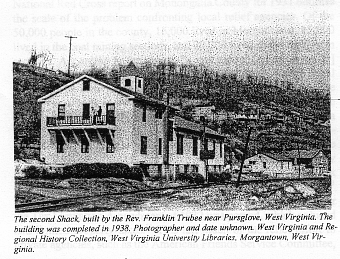
These
interrelated themes of paralyzing poverty, unsanitary
living conditions, absentee ownership, and corollary
problems such as poor education, were taken up
during the 1930s by reporters for national publications,
who detailed a prose picture of Scotts Run as
the symbol of the destitution to be found in the
coal fields. One article, in particular, has been
referred to so many times since 1935 when it was
published by the Atlantic Monthly that the phrase
"the damnedest cesspool of human misery I
have ever seen in America" has become synonymous
with Scotts Run.(22)
Even
before Mrs. Roosevelt threw her considerable influence
behind the struggle to improve living conditions
on the run, others had long been busy in that
same enterprise. The Coal Relief Campaign of the
American Friends Service Committee (AFSC) was
already on the scene when Mrs. Roosevelt called
Clarence E. Pickett, executive secretary of the
AFSC, about inspecting conditions in the coal
fields first hand. Pickett and Alice O. Davis,
director of the Morgantown district, met with
Mrs. Roosevelt and helped to establish the itinerary
which brought her to the county and Scotts Run.
With her came the inevitable corps of newspaper
reporters, soon followed by some of America's
most famous photographers, such as Lewis Hine,
Walker Evans, Marion Post Walcott, and Ben Shahn:
Their photographs captured the human face of the
Depression and I provided the visual images which
confirmed the written text. They heightened the
nation's consciousness about Scotts Run, and while
it became easier for social agencies to justify
their work and to raise scarce resources for the
relief effort, the symbol also became a fixture
in the iconography of the public imagination.
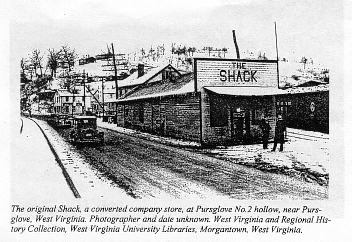
The
American Friends Service Committee, and the various
federal relief agencies, brought a strong presence
to Scotts Run, but it would be a mistake to interpret
the appearance of these national organizations
as the first demonstration of concern for the
plight of these stranded miners and their families.
In fact, local agencies, particularly the Council
of Social Agencies and the County Welfare Board,
had been struggling for years to improve the human
condition on Scotts Run. The burden simply had
proven too great for local agencies alone, and
Monongalia County was virtually bankrupt. A National
Red Cross report on Monongalia County for 1931
outlines the scale of the problem confronting
local relief agencies. Of the 50,000 people in
the county, 16,000 lived in Morgantown, 15,000
lived in the coal mining sections, and 20,000
lived in the rural farm sections. According to
the report, "a vast amount of miner's [sic]
children are being fed by charitable organizations."
A nutritional survey undertaken in the mining
sections revealed that in "some instances
as high as 40 percent of the children were found
to be suffering from malnutrition with an average
of 26 percent. Quite a few of the children are
without sufficient clothing and shoes." Compounding
the problem was the closure of every bank in the
county. According to the Red Cross report for
1931, "the county funds have been tied up
in the closed banks and it looks as if tax collections
for the fiscal year are going to be considerably
short." (23)

The problem of tax revenues became even worse
in 1933 after the Tax Limitation Amendment of
1932 was passed, which reduced and limited property
taxes.24 This left much of the relief effort to
private agencies, such as the American Friends
Service Committee, which served 128,692 meals
to children in the mine camps of Monongalia County
between the Septembers-of 1931 and 1932. One half
of its twenty-four feeding stations in Monongalia
County were located in the Scotts Run area, and
by far the largest majority of meals were served
there.(25)
The
earliest, and most personalized, local relief
efforts drew their inspiration from the Bible
School Movement and the Settlement House Movement.
The Bible School Movement depended on trained
lay-workers and volunteers to teach the principles
of Christianity to the "religiously needy"
but gave primary attention to the children. Most
ofthe workers were young women who followed this
avenue to leadership roles unavailable to them
within the conventional structure of the church.(26)
Young women also played a major role in the Settlement
House Movement, the best known example being Jane
Addarns's Hull House in Chicago. Settlement houses
attempted to assist in the "Americanization"
of newly arrived immigrants by promoting English
literacy, citizenship, hygiene, and other basic
adaptive social and life skills. (27)
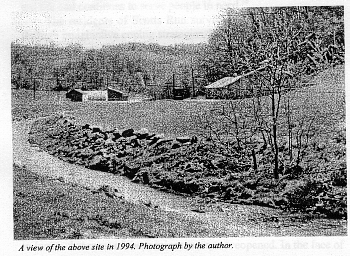
The goals of both movements converged on Scotts
Run during the 1920s, when Methodist and Presbyterian
churches in Morgantown expanded their work among
the mining families on the run. The Scotts Run
Settlement House began in 1922 when the Women's
Home Missionary Society of Wesley Methodist Church
established a Bible school for children under
the direction of Deaconess Edna L. Muir and Pearl
E. Shriver. In addition to Bible school and Sunday
school, the settlement house gradually expanded
its program to include classes on naturalization,
cooking, motherhood, and other life skills. A
permanent building for the settlement house in
Osage was completed in 1927 and continues to this
day to offer assistance to those in need.(28)
The
Morgantown First Presbyterian Church also sent
a Christian worker, Mary Behner, to establish
a missionary project on Scotts Run. Ms. Behner
began her work at Pursglove in 1928, almost exactly
one year after the Methodist Settlement House
was completed. Programs similar to those at the
settlement house were initiated in a local school,
but in 1931, a mine building was converted into
a community center for Ms. Behner's work. Local
residents called it "The Shack," and
the name stuck.(29)
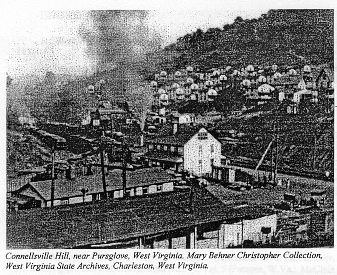
In
1938, the Reverend Franlclin Trubee, the first
ordained Presbyterian missionary to be stationed
on Scotts Run, became the director of The Shack.
He built a new and larger Shack and readily adopted
the methods and philosophical approach of the
American Friends Service Committee, developing
local leadership, and promoting rehabilitation
(helping people to help themselves) through cooperative
exchanges of labor and goods. The unemployed needed
no cash when they participated in the Scotts Run
Reciprocal Economy, The Shack's cooperative. Most
residents could not practice supplemental farming
or extensive gardening as they did elsewhere in
the coal fields because acrid fumes from the smoldering
"gob" piles killed all the vegetation
in the hollow, and congestion from over-development
precluded other uses of the land. However, through
the co-op they exchanged their labor for produce
raised in the hilltop community gardens or for
reconditioned clothing from the recycled clothing
shop. Now in its third building, The Shack, like
the settlement house, has adapted to the circumstances
of modern life and continues to serve people in
need.(30)
The
residents of Scotts Run survived the Great Depression
through imaginative coping strategies, but the
1930s marks the beginning of a long slide into
historical obscurity for this once teeming hollow.
A number of explanations account for Scotts Run's
short life and slow agonizing decline. The Great
Depression, of course, was a national calamity,
and Scotts Run residents probably suffered more
than most Americans from the debilitating effects
of unemployment, ignorance, ethnic and racial
prejudice, and the other manifestations of abject
poverty. Many left the area in search of a better
life. As elsewhere in rural America, World War
II took many of the young men from Scotts Run,
and after the war they found little incentive
to return.(31)
Technological
change also played a role in the decline of Scotts
Run. The development of diesel engines for locomotives
eliminated a major source of demand for Scotts
Run's famous steam coal, and the rapid loss of
market share to other sources of energy also helped
to insure that most of these mines were not reopened.
In the face of these market changes, the entire
mining industry began a long process of restructuring.
By the 1950s, the numerous coal tracts on the
run had been consolidated into a few large parcels,
most notably those controlled by Consolidation
Coal Company. Mechanization of the mines took
a heavy toll on the labor force everywhere, and
Scotts Run was no exception. With little chance
of employment, miners and their families moved
elsewhere in search of a better life. Their departure
was facilitated by the construction of better
roads and by the widespread ownership of automobiles
after World War II. Finally, the construction
of Interstate 79, which was opened in Monongalia
County in 1974, displaced many residents where
it wrapped around Connellsville Hill, dissecting
Scotts Run between Pursglove and Liberty.(32)
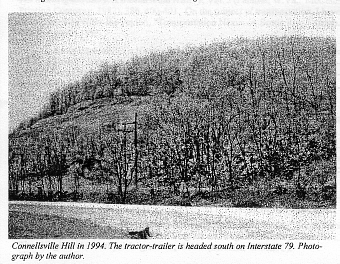
There
was one additional reason for the decline of Scotts
Run: the federal government resettled hundreds
of the native-born white, and most assimilated,
residents. According to one authority, Eleanor
Roosevelt could not solve all of the problems
she found in the coal fields, "but because
she had actually seen Scotts Run" the First
Lady felt compelled to do "something more."
Something more resulted in the conception and
construction of Arthurdale, in nearby rural Preston
County.
Arthurdale
was the first of approximately 99 experimental
communities established by federal agencies to
relocate redundant industrial workers from the
squalor of slums into the more forgiving rural
countryside. The first lady described the desperation
she found on Scotts Run so compellingly that President
Roosevelt ordered his aide, Louis Howe, to cut
through the red tape and purchase the two thousand
acres of farmland for the resettlement community
that Mrs. Roosevelt had in mind. In the end, 165
families moved to Arthurdale, two-thirds of which
originated from Scotts Run.(33)
Arthurdale
represented a uniquely American response to a
social problem, and much of the community spirit
still resonates sixty years later as testimony
to the power of the original dream. Scotts Run
was unique too, but in the public imagination,
it represents the dark side of the American Dream
captured forever in haunting photographs, icons
of the human misery wrought by the Great Depression
in the coal fields.
ENDNOTES
I.
"West Virginia Output Shows Decrease,"
BlackDiamond 68 (28 January 1922): 85.
2.
"Wonder Coal Field of West Virginia,"
Black Diamond 71 (11 August 1923): 180-181; "Sewickley
Coal is Premier Steam Fuel," BlackDiamond71
(11 August 1923): 185.
3.
I. C. White, "Morgantown's Wealth of Fuel,"
Black Diamond 71 (11 August 1923): 178-179.
4.
Howard N. Eavenson, The First Century and a Quarter
of the American Coal Industry (Pittsburgh: By
the Author, 1942), 418; West Virginia Geological
Survey, Characteristics of Mineable Coals of West
Virginia, Vol. 8, A. J. W. Headlee and J. P. Nolting,
Jr., eds. (Morgantown, W. Va.: West Virginia Geological
Survey, 1940), 9-10; Phil Ross, "The Scotts
Run Coalfield from the Great War to the Great
Depression: A Study in Overdevelopment,"
West Virginia History, 53 (1994): 22.
5.
White, "Morgantown's Wealth of Fuel,"
178-179; A. B. Brooks, Forestry and Wood lndustries,
Vol. 5 (Morgantown, W.Va.: West Virginia Geological
Survey, 1911), 28.
6.
Morgantown (W. Va.) Post-Chronicle, 15 September
1910; Earl L. Core, The Monongalia Story: A Bicentennial
History, Vol. 5 (Parsons, W.Va.: McClain Printing
Company, 1982),386, 400-401. On the subject of
transportation, I have been guided by Billy Joe
Peyton, "Transportation Nexus on Scotts Run,"
unpub. Seminar paper, 1993.
7.
Morgantown (W. Va.)Dominion-News,12 December 1971;
Morgantown (W.Va) Post, 19 September 1972, and
18 December 1972; Earl L. Core, Chronicles of
Core (Parsons, WV: McClain Printing Company, 1975),
192; Morgantown (W. Va.) Post, I November 1921;
Black Diamond 72 (15 March 1924): 315.
8.
White, "Morgantown's Wealth of Fuel,"
179.
9.
"Suit Held Vital One," Black Diamond
72 (8 March 1924): 273; "Denies Endangering
Sewickley Seam," Black Diamond 72 (24 May
1924): 619.
10.
Matthew Yeager, "Scotts Run: A Community
in Transition," West Virginia History 53
(1994): 14; U. S. Census of Population; The quotation
is from "Sewickley Coal is Premier Steam
Fuel," Black Diamond 71 (11 August 1923):
185.
11.
1920 Manuscript Census, Cass District, Monongalia
County, West Virginia.
12.
Ibid.; "Report of Missionary Survey in Scotts
Run, W.Va,," Scotts Run Community Center,
A & M 652, West Virginia and Regional History
Collection, West Virginia University, Morgantown,
W.Va. (hereafter WVRHC).
13.
James P. Johnson, The Politics of Soft Coal: The
Bituminous Industry from World War I through the
New Deal (Urbana: University of Illinois Press,
1979).
14.
Michael E. Workman, "The Fairmont Coal Field,"
in Michael E. Workman, Paul Salstrom, and Philip
W. Ross, Northern West Virginia Coal Fields: Historical
Context, Technical Report No.10 (Morgantown, W.Va.:
Institute for the History of Technology and Industrial
Archaeology, 1994): 36; Coal Age 21 (29 June 1922),
1099.
I5.
Workman, et al, "The Fairmont Coal Field,"
36.
16.
Ibid.,36-37.
17.
George E. Smith to Walter Davidson, 22 May 1931,
Records of the American National Red Cross, 1917-1934,
File 868, Box 701, RG 200, National Archiives
(hereafter NA).[Thanks to Sandra Barney for this
item].
18.
Linda Nyden, "Black Miners in Western Pennsylvania,1925-1931:
The National/Miners Union and the United Mine
Workers of America," Science and Society
41 (Spring 1977) For strike conditions and the
NMU on Scotts Run, see Stephen Edward Haid Arthurdale:
An Experiment in Community Planning, 1933-1947,
West Virginia University, 1975), Chapter 1.
19.
Doris Faber, The Life of Lorena Hickok (New York:
William Morrow and Company, Inc., 1980), 143-144.
20.
Eleanor Roosevelt, This I Remember (New York:
Harper & Row Publishers - 949), 129.
21.
Ibid., 126-129.
22.
William E. Brooks, "Arthurdale--A New Chance,"
Atlantic Monthly
155 (February 1935), 199.
23.
Narrative Report, April-October 1931, Records
of the American National Red Cross, 1917- 1934,
File 1310, Box 73, RG 90, NA. [Thanks to Sandra
Barney for this item]. For health conditions on
Scotts Run, see Sandra Barney, "Health Services
in a Stranded Coal Community: Scotts Run, 1920-1947,"
West Virginia History 53 (1994): 43-55.
24.
Charles H. Ambler, A History of Education in West
Virginia from Early Colonial Times to 1949 (Huntington,
W.Va.: Standard Printing & Publishing Company,
1951), 607-609.
25.
American Friends Service Committee, Report of
the Child Relief Work in the Bituminous Coal Fields,
September 1, 1931 - August 31, 1932 (Philadelphia:
AFSC, 1932), 27.
26.
Marcia Clark Myers, "Presbyterian Home Mission
in Appalachia: A Feminine Enterprise," American
Presbyterians 71 (Winter 1993): 253-264. For the
Bible School Movement, see Virginia Lieson Brereton,
Training God 's Army: The American Bible School,
1880-1940 (Bloomington: Indiana University Press,
1990).
27.
For the best contemporary account of the urban
settlement house movement, see Jane Addams, Twenty
Years at Hull-House (New York: The McMillan Company,1910).
For the best modern assessment of the movement,
see Allen F. Davis, American Heroine: The Life
and Legend of Jane Addams (New York: Oxford University
Press, 1973).
28.
Edna Leona Muir, "Scotts Run Settlement Work,"
n.d., and Lena Brookover Barker, "The History
of Scotts Run Settlement House," Autumn 1938,
both in the Settlement House Collection, WVRHC.
Pearl E. was the wife of Frank C. Shriver, president
and General Manager of the Monogahela Supply Company
in Morgantown. Morgantown City Directory 1927-1928,
WVRHC.
29.
Scotts Run Scrapbook, WVRHC; Bettijane Burger,
"Mary Elizabeth Behner Christopher, 1906-
," in Missing Chapters 11: West Virginia
Women in History (Charleston, W.Va.: West Virginia
Women's Commission, 1986), 51; See also, Christine
M. Kreiser, "'I Wonder Whom God Will Hold
Responsible?' Mary Behner and the Presbyterian
Mission on Scotts Run," West Virginia History
53 (1994): 61-92.
30.
"'Why Don't You Bake Bread?' Franklin Trubee
and the Scotts Run Reciprocal Economy," interview
by Ronald L. Lewis, Goldenseal 15(Spring 1989):
34-41.
31.
For an example of this process, see the autobiography
of a former Osage resident, Sidney D. Lee, And
the Trees Cried (By the Author, 1991).
32.
Earl L. Core, The Monongalia Story: A Bicentennial
History, Vol. 5 (Parsons, W.Va.: McClain Printing
Company, 1984), 479-480.
33.
Haid, "Arthurdale," 68-70; Faber, The
Life of Lorena Hickok, 146.
Return
to History of the Area |